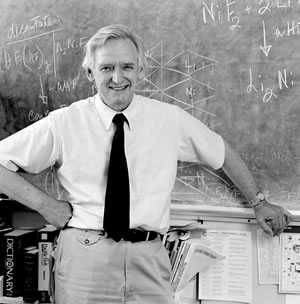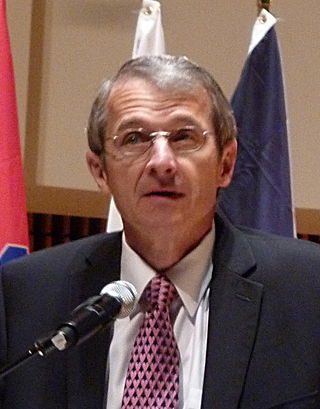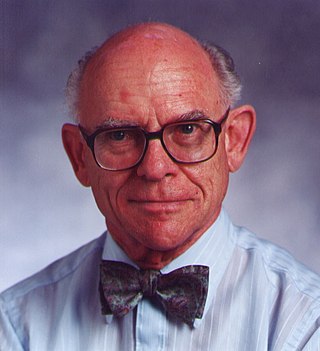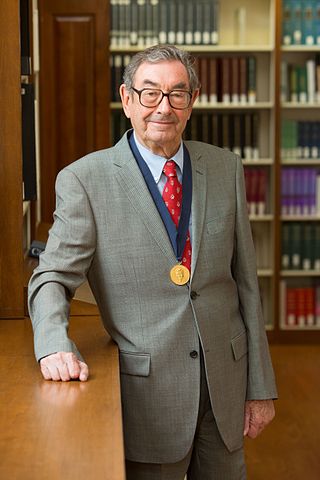Related Research Articles

Neil Bartlett was a British chemist who specialized in fluorine and compounds containing fluorine, and became famous for creating the first noble gas compounds. He taught chemistry at the University of British Columbia and the University of California, Berkeley.

Henry Taube, was a Canadian-born American chemist who was awarded the 1983 Nobel Prize in Chemistry for "his work in the mechanisms of electron-transfer reactions, especially in metal complexes." He was the second Canadian-born chemist to win the Nobel Prize, and remains the only Saskatchewanian-born Nobel laureate. Taube completed his undergraduate and master's degrees at the University of Saskatchewan, and his PhD from the University of California, Berkeley. After finishing graduate school, Taube worked at Cornell University, the University of Chicago and Stanford University.

Richard Royce Schrock is an American chemist and Nobel laureate recognized for his contributions to the olefin metathesis reaction used in organic chemistry.

Malcolm Leslie Hodder Green was Professor of Inorganic Chemistry at the University of Oxford. He made many contributions to organometallic chemistry.

Frank Albert Cotton FRS was an American chemist. He was the W.T. Doherty-Welch Foundation Chair and Distinguished Professor of Chemistry at Texas A&M University. He authored over 1600 scientific articles. Cotton was recognized for his research on the chemistry of the transition metals.

Harry Barkus Gray is the Arnold O. Beckman Professor of Chemistry at California Institute of Technology.
Christopher David Garner FRSC FRS is a British retired chemist, whose research work was in the growing field of Biological Inorganic Chemistry. His research primarily focussed on the role of transition metal elements in biological processes, for which he published over 400 original papers and reviews on the topic. His specific interests lie in the roles of Molybdenum and Tungsten as the metal centres in various enzyme cofactors based on the molybdopterin molecule.

Stephen James Lippard is the Arthur Amos Noyes Emeritus Professor of Chemistry at the Massachusetts Institute of Technology. He is considered one of the founders of bioinorganic chemistry, studying the interactions of nonliving substances such as metals with biological systems. He is also considered a founder of metalloneurochemistry, the study of metal ions and their effects in the brain and nervous system. He has done pioneering work in understanding protein structure and synthesis, the enzymatic functions of methane monooxygenase (MMO), and the mechanisms of cisplatin anticancer drugs. His work has applications for the treatment of cancer, for bioremediation of the environment, and for the development of synthetic methanol-based fuels.

Norman Neill Greenwood FRS CChem FRSC was an Australian-British chemist and Emeritus Professor at the University of Leeds. Together with Alan Earnshaw, he wrote the textbook Chemistry of the Elements, first published in 1984.
George Michael Sheldrick, FRS is a British chemist who specialises in molecular structure determination. He is one of the most cited workers in the field, having over 280,000 citations as of 2020 and an h-index of 113. He was a professor at the University of Göttingen from 1978 until his retirement in 2011.
Clifford P. Kubiak is an American inorganic chemist, currently a Distinguished Professor in Chemistry and Biochemistry and the Harold C. Urey Chair in Chemistry at the University of California, San Diego. Over the course of his career, Kubiak has published over 200 scientific articles. He has also received the American Chemical Society Award in Inorganic Chemistry, and is a Fellow of the American Academy of Arts and Sciences and American Chemical Society. In 2020 he was elected to the National Academy of Sciences.
Russell P. Hughes an American/British chemist, is the Frank R. Mori Professor Emeritus and research professor in the Department of Chemistry at Dartmouth College. His research interests are in organometallic chemistry, with emphasis on the chemistry of transition metal complexes interacting with fluorocarbons. His research group's work in this area led to several creative syntheses of complexes of transition metal and perfluorinated hydrocarbon fragments.
Ulrich Müller is a German chemist who is known for his works on solid-state chemistry and the application of crystallographic group theory to crystal chemistry. He is the author of several textbooks on chemistry, solid-state chemistry, and crystallography.
Nathan C. Gianneschi is the Jacob & Rosaline Cohn Professor of Chemistry, Materials Science & Engineering, and Biomedical Engineering at Northwestern University and the Associate Director for the International Institute for Nanotechnology. Gianneschi's lab takes an interdisciplinary approach to nanomaterials research, with a focus on multifunctional materials for biomedical applications, programmed interactions with biomolecules and cells, and basic research into nanoscale materials design, synthesis and characterization.

Roman Gladyshevskii is a Ukrainian chemist, academician of the National Academy of Sciences of Ukraine, Doctor of Chemistry, professor, vice-rector for research of University of Lviv.
Davita L. Watkins is an associate professor of chemistry at the University of Mississippi, where her research interest is in developing supramolecular synthesis methods to make new organic semiconducting materials for applications in optoelectronic devices, as well as studying their structural, optical, and electronic properties. Her group also investigates the design of dendrimer molecules for biomedical applications.

Karin Aurivillius (1920–1982) was a Swedish chemist and crystallographer at the University of Lund, Sweden. She determined the crystal structures of many mercury compounds.
Rory Waterman is an American chemist. He is a full professor and associate dean of inorganic, organometallic, and catalysis at the University of Vermont.
Karsten Meyer is a German inorganic chemist and Chair of Inorganic and General Chemistry at the Friedrich-Alexander University of Erlangen-Nürnberg (FAU). His research involves the coordination chemistry of transition metals as well as uranium coordination chemistry, small molecule activation with these coordination complexes, and the synthesis of new chelating ligands. He is the 2017 recipient of the Elhuyar-Goldschmidt Award of the Spanish Royal Society of Chemistry, the Ludwig-Mond Award of the Royal Society of Chemistry, and the L.A. Chugaev Commemorative Medal of the Russian Academy of Sciences, among other awards. He also serves as an Associate Editor of the journal Organometallics since 2014.
Alexander Frank Wells, or A. F. Wells, was a British chemist and crystallographer. He is known for his work on structural inorganic chemistry, which includes the description and classification of structural motifs, such as the polyhedral coordination environments, in crystals obtained from X-ray crystallography. His work is summarized in a classic reference book, Structural inorganic chemistry, first appeared in 1945 and has since gone through five editions. In addition, his work on crystal structures in terms of nets have been important and inspirational for the field of metal-organic frameworks and related materials.
References
- ↑ "Remembering Professor Arnold Rheingold". Cambridge Crystallographic Data Centre. Retrieved 25 April 2024.
- "CV of Arnold L. Rheingold". ISIhighlycited.com. Archived from the original on 2007-05-19. Retrieved 2007-11-10.
- "Interview with Arnold L. Rheingold" . Retrieved 2007-11-10.
- "Remembering Professor Arnold Rheingold" . Retrieved 2024-04-25.